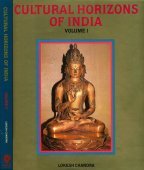Saddharma, Ṣaḍdharma, Sash-dharma: 11 definitions
Introduction:
Saddharma means something in Buddhism, Pali, Hinduism, Sanskrit, Jainism, Prakrit, Marathi. If you want to know the exact meaning, history, etymology or English translation of this term then check out the descriptions on this page. Add your comment or reference to a book if you want to contribute to this summary article.
The Sanskrit term Ṣaḍdharma can be transliterated into English as Saddharma or Shaddharma, using the IAST transliteration scheme (?).
Images (photo gallery)
In Hinduism
Purana and Itihasa (epic history)
Source: archive.org: Shiva Purana - English TranslationSaddharma (सद्धर्म) refers to “good virtue”, according to the Śivapurāṇa 2.5.16 (“The battle of the gods”).—Accordingly, as Brahmā and the Gods eulogized Viṣṇu: “[...] Obeisance to you of the form of Kalki; the destroyer of outcastes, Obeisance to him of infinite power and who establishes good virtue (saddharma-sthāpana) . Obeisance to you of the form of Kapila of great soul and who expounded the doctrines of Sāṃkhya and Yoga to Devahūtī; O lord, obeisance to you the preceptor of Sāṃkhya. Obeisance to great yogin and saint who expounds the great wisdom. Obeisance to the creator of the form of knowledge whereby the soul is delighted. [...]”.

The Purana (पुराण, purāṇas) refers to Sanskrit literature preserving ancient India’s vast cultural history, including historical legends, religious ceremonies, various arts and sciences. The eighteen mahapuranas total over 400,000 shlokas (metrical couplets) and date to at least several centuries BCE.
In Buddhism
Mahayana (major branch of Buddhism)
Source: Wisdom Library: Maha Prajnaparamita SastraSaddharma (सद्धर्म) refers to the “true doctrine”, according to Mahāprajñāpāramitāśāstra (chapter 2).—Accordingly, “[Question.—Why do the Buddhist sūtras begin with the words: ‘Thus have I heard’?]—[...] In all worldly people, the three types of language, wrong views, pride and convention, exist. In the śaikṣas on the path of seeing, there are two types of language, that of pride and that of convention. In the Āryas, only the conventional language exists. Without inwardly condemning the true doctrine (saddharma), they imitate ordinary people and borrow their language. Rejecting the wrong views of the world, they conform to usage and avoid quarrels; thus they reject the other two impure roots of language. By conforming to the world, they use only one kind of language, i.e., conventional language. The Buddha’s disciples who speak about the Ātman, by conforming to usage, are not committing a fault”.
Source: academia.edu: A Study and Translation of the GaganagañjaparipṛcchāSaddharma (सद्धर्म) refers to the “true religion”, according to the Gaganagañjaparipṛcchā: the eighth chapter of the Mahāsaṃnipāta (a collection of Mahāyāna Buddhist Sūtras).—Accordingly, “[...] Son of good family, when the Bodhisattva is unbreakable (abhedya) having made a resolve as firm as a diamond with the twelve qualities, he is not disturbed by the world with its gods. What are those twelve? [...] (9) endless offerings for the sake of obtaining the characteristics of a great man and the marks of beauty are unbreakable; (10) giving up body and life in order to uphold the true religion (saddharma-parigraha) is unbreakable; (11) dedicating his roots of good for the sake of other beings is unbreakable; (l2) his accumulation of all qualities of the Buddha is unbreakable.[...]”.

Mahayana (महायान, mahāyāna) is a major branch of Buddhism focusing on the path of a Bodhisattva (spiritual aspirants/ enlightened beings). Extant literature is vast and primarely composed in the Sanskrit language. There are many sūtras of which some of the earliest are the various Prajñāpāramitā sūtras.
Tibetan Buddhism (Vajrayana or tantric Buddhism)
Source: WikiPedia: VajrayanaṢaḍdharma (षड्धर्म) refers to the “six dharmas of Nāropa and represents a set of advanced Tibetan Buddhist Tantric practices compiled by the Indian Mahasiddhas Tilopa and Nāropa (1016-1100 CE) and passed on to the Tibetan translator-Yogi Marpa Lotsawa (c. 1012).—The six Dharmas are intended to lead to Buddha-hood in an accelerated manner. They traditionally require Tantric initiation and personal instruction through working with a Tantric Guru as well as various preliminary practices. The six Dharmas work with the subtle body, particularly through the generation of inner heat (tummo) energy.
The most widely used list of six Dharmas (ṣaḍdharma) in the work of the Kagyu school figure Gampopa conforms to the following list:
- tummo (Tibetan: གཏུམ་མོ་, Wylie: gtum mo; Sanskrit: caṇḍālī) – the Yoga of inner heat (or mystic heat).
- ösel (Tibetan: འོད་གསལ་, Wylie: od gsal; Sanskrit: prabhāsvara) – the Yoga of clear light, radiance or luminosity.
- milam (Tibetan: རྨི་ལམ་, Wylie: rmi lam; Sanskrit: svapnadarśana) – the Yoga of the dream state.
- gyulü (Tibetan: སྒྱུ་ལུས, Wylie: sgyu lus; Sanskrit: māyākāyā) – the Yoga of the illusory body.
- bardo (Tibetan: བར་དོ, Wylie: bar do; Sanskrit: antarābhava) – the Yoga of the intermediate state.
- phowa (Tibetan: འཕོ་བ་, Wylie: pho ba; Sanskrit: saṃkrānti) – the Yoga of the transference of consciousness to a pure Buddha-field.

Tibetan Buddhism includes schools such as Nyingma, Kadampa, Kagyu and Gelug. Their primary canon of literature is divided in two broad categories: The Kangyur, which consists of Buddha’s words, and the Tengyur, which includes commentaries from various sources. Esotericism and tantra techniques (vajrayāna) are collected indepently.
In Jainism
General definition (in Jainism)
Source: The University of Sydney: A study of the Twelve ReflectionsSaddharma (सद्धर्म) refers to “true faith”, according to Pūjyapāda’s Sarvārthasiddhi.—Accordingly, “[...] Even if human birth is attained, a good country, a good family, keen senses, health, etc. are more and more difficult of attainment. When all these are attained, if true faith is not acquired (saddharma-pratilambha), human birth becomes useless like the face without vision. And even after attaining this rare true faith, if anyone is immersed in worldly pleasures, it is like burning sandal-wood paste for the sake of ash. [...]”.

Jainism is an Indian religion of Dharma whose doctrine revolves around harmlessness (ahimsa) towards every living being. The two major branches (Digambara and Svetambara) of Jainism stimulate self-control (or, shramana, ‘self-reliance’) and spiritual development through a path of peace for the soul to progess to the ultimate goal.
Languages of India and abroad
Marathi-English dictionary
Source: DDSA: The Molesworth Marathi and English Dictionarysaddharma (सद्धर्म).—m (S) A good property or quality. 2 A good religion: also a good religious practice or observance. 2 Used laxly in the sense of sadā- caraṇa Good conduct or course; righteous and just walk. sa0 bāḷagaṇēṃ- sambhāḷaṇēṃ -rākhaṇēṃ To uphold good religion or a good rite or religious custom. And sa0 ṭākaṇēṃ- sōḍaṇēṃ &c. To renounce or relinquish it. saddharmānēṃ cālaṇēṃ- vāgaṇēṃ- rāhaṇēṃ- asaṇēṃ To walk in truth and righteousness. saddharmālā jāgaṇēṃ To be careful of moral obligations; to watch to do what is right. saddharmāsa yēṇēṃ To commend itself unto; to appear right in the eyes of. saddharmāvara ṭākaṇēṃ -ghālaṇēṃ-lōṭaṇēṃ-sōḍaṇēṃ To cast (a matter) upon the good conscience or sense of propriety of.
Source: DDSA: The Aryabhusan school dictionary, Marathi-Englishsaddharma (सद्धर्म).—m A good property or quality; good religion.
Marathi is an Indo-European language having over 70 million native speakers people in (predominantly) Maharashtra India. Marathi, like many other Indo-Aryan languages, evolved from early forms of Prakrit, which itself is a subset of Sanskrit, one of the most ancient languages of the world.
Sanskrit dictionary
Source: Cologne Digital Sanskrit Dictionaries: Cappeller Sanskrit-English DictionarySaddharma (सद्धर्म).—[masculine] the good law.
Source: Cologne Digital Sanskrit Dictionaries: Monier-Williams Sanskrit-English Dictionary1) Saddharma (सद्धर्म):—[=sad-dharma] [from sad > sat] m. the good law, true justice, [Rāmāyaṇa; Purāṇa]
2) [v.s. ...] (with Buddhists and Jainas) designation of the Buddhist or Jaina doctrines, [Buddhist literature; Inscriptions]
[Sanskrit to German]
Sanskrit, also spelled संस्कृतम् (saṃskṛtam), is an ancient language of India commonly seen as the grandmother of the Indo-European language family (even English!). Closely allied with Prakrit and Pali, Sanskrit is more exhaustive in both grammar and terms and has the most extensive collection of literature in the world, greatly surpassing its sister-languages Greek and Latin.
Kannada-English dictionary
Source: Alar: Kannada-English corpusSaddharma (ಸದ್ಧರ್ಮ):—
1) [noun] good behaviour, virtuous conduct.
2) [noun] a man of good behaviour, virtuous conducts.
Kannada is a Dravidian language (as opposed to the Indo-European language family) mainly spoken in the southwestern region of India.
See also (Relevant definitions)
Partial matches: Shash, Dharma, Sat, Tarma.
Starts with: Saddharma Pundarika Sutra, Saddharma-Pundarika Sutra, Saddharmacandrodaya, Saddharmacarini, Saddharmacintamani, Saddharmaghoshambaradiparaja, Saddharmalankavatara, Saddharmapundarika, Saddharmasalila, Saddharmasamparigraha, Saddharmasmrityupasthana, Saddharmasthapana, Saddharmatattvakhyahnika, Saddharmate, Saddharmavarsha, Saddharmavid.
Ends with: Asaddharma, Sakshaddharma.
Full-text (+175): Lankavatara, Parigrahaka, Saddharmacintamani, Saddharmalankavatara, Saddharmasamparigraha, Saddharmacandrodaya, Saddharmatattvakhyahnika, Saddhamma, Saddharmapundarika, Aparyeshita, Viprasidati, Saddharmi, Saddharmate, Pratikshaya, Saddharmika, Samparigraha, Tanaka, Desana, Traidhatuka, Aparyeshta.
Relevant text
Search found 31 books and stories containing Saddharma, Ṣaḍ-dharma, Sad-dharma, Ṣaḍdharma, Sas-dharma, Ṣaṣ-dharma, Ṣaṣdharma, Sasdharma, Sash-dharma, Sashdharma, Shad-dharma; (plurals include: Saddharmas, dharmas, Ṣaḍdharmas, Ṣaṣdharmas, Sasdharmas, Sashdharmas). You can also click to the full overview containing English textual excerpts. Below are direct links for the most relevant articles:
Maha Prajnaparamita Sastra (by Gelongma Karma Migme Chödrön)
Part 3 - Morality of the śikṣamāṇā < [Section II.2 - Morality of the monastic or pravrajita]
II.7. Other qualities of the Buddhist Dharma < [II. Recollection of the Dharma (dharmānusmṛti)]
Part 3 - The Prajñā and the teaching of the Dharma < [Chapter XXX - The Characteristics of Prajñā]
Brihad Bhagavatamrita (commentary) (by Śrī Śrīmad Bhaktivedānta Nārāyana Gosvāmī Mahārāja)
Verse 1.1.41-42 < [Chapter 1 - Bhauma (the earthly plane)]
Verse 1.4.112 < [Chapter 4 - Bhakta (the devotee)]
Verse 1.1.12 < [Chapter 1 - Bhauma (the earthly plane)]
Garga Samhita (English) (by Danavir Goswami)
Verse 3.7.35 < [Chapter 7 - The Holy Places of Śrī Girirāja]
Bhakti-rasamrta-sindhu (by Śrīla Rūpa Gosvāmī)
Verse 1.2.103 < [Part 2 - Devotional Service in Practice (sādhana-bhakti)]
Verse 1.2.76 < [Part 2 - Devotional Service in Practice (sādhana-bhakti)]
Chaitanya Bhagavata (by Bhumipati Dāsa)
Verse 1.2.167 < [Chapter 2 - The Lord’s Appearance]
Related products

